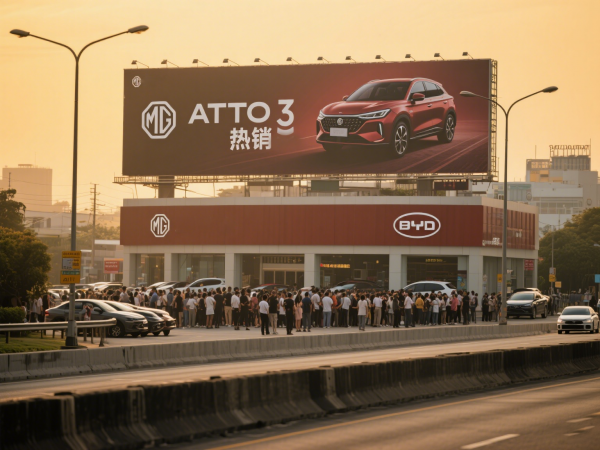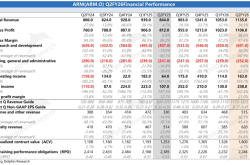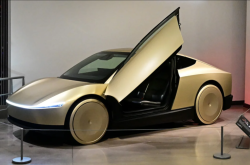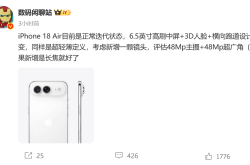Chinese automakers are too powerful, Japanese cars can't hold the Southeast Asian market
![]() 06/19 2025
06/19 2025
![]() 433
433

The key is to establish a brand and build systematic and localized capabilities.
Text | Hua Shang Tao Lue Qi Ce
There was once a rumor in the industry:
Thailand International Motor Expo, the most important auto show in Southeast Asia, used to announce the real-time sales ranking of each brand every day. For decades, Toyota has always been at the top.
However, at the 2023 auto show, when a Chinese automaker received a large order of several hundred vehicles, and its total sales would surpass Toyota for the first time according to the counting rules, the organizer refused to update the data on the grounds that "the order submission time had passed."
[Chinese cars are selling like hotcakes!]
On the highway from Bangkok's Suvarnabhumi Airport to the city, it's hard for people not to be attracted by the huge outdoor advertisements along the road. The billboards of three Chinese automakers, SAIC MG, BYD, and GAC Aion, are arranged in sequence, occupying the best and most expensive outdoor advertising spaces in Bangkok.
As the largest automobile manufacturer in Southeast Asia, Thailand is the first stop for many Chinese automakers to enter the Southeast Asian market, leading to the saying in the industry that "whoever wins Thailand wins Southeast Asia."
If we have to choose the most representative company, BYD is undoubtedly the one.
BYD's connection with Thailand dates back to 2013, when BYD delivered a batch of electric buses to the Thai market. Starting in 2017, BYD's passenger vehicles also gradually penetrated the Thai market, but it was not until August 2022 that BYD officially announced its entry into the Thai market, launching its first model, the ATTO 3 (corresponding to the domestic Yuan PLUS), in November.
Due to sufficient promotion before the launch, long queues formed in front of multiple BYD stores in Bangkok starting from the midnight of the ATTO 3's launch day. Due to the large number of car buyers, the stores even implemented a ticket system for car purchases, with the scene as fiery as the night before the release of a new Apple product. It was also thanks to the popularity of the ATTO 3 that BYD became the top player in the Thai auto market overnight.
According to data from Thailand's Auto Life official website, in the first full year after entering the Thai market, the Atto 3 topped the electric vehicle sales chart with 19,000 units sold, capturing 25% of the market share. Then, in 2024, BYD continued its rapid growth, selling 27,000 electric vehicles in Thailand, accounting for nearly 40% of the electric vehicle market.
BYD's performance is just a microcosm of the Chinese automakers' presence in the Southeast Asian market. Last year, both BYD and MG entered the top ten of Thailand's annual auto sales list, with NIO, Changan, and GAC ranking 12th, 14th, and 15th, respectively, in sales.
At the recently held 46th Bangkok International Motor Show, Chinese automotive brands shone brightly. Among the 26 large exhibitors, Chinese automotive brands occupied 10 booths, with their exhibition area accounting for half of the entire venue. Moreover, half of the top 10 automotive brands in terms of pre-orders at the show were Chinese brands.

The rise of Chinese automotive brands in the Southeast Asian market inevitably threatens the market share of Japanese cars. Since the 1960s, Japanese cars have entered the Southeast Asian market in force, replacing American cars with their reliability and economy, becoming the dominant force in the market. The share of Japanese cars in the Southeast Asian market once exceeded 70%, making it an absolute stronghold for Japanese cars.
However, with the influx of Chinese automakers, the monopoly of Japanese cars in Southeast Asia has begun to be challenged.
In the first quarter of this year, sales of Chinese cars in the four major Southeast Asian markets of Indonesia, Malaysia, Thailand, and the Philippines increased by more than 58% compared to the previous year. In sharp contrast, the market share of Japanese cars has continued to decline.
According to exclusive data analysis by Bloomberg, from 2019 to 2024, Japanese automakers lost the most market share among all automakers (by country) in China, Singapore, Thailand, Malaysia, and Indonesia.
Especially in Thailand and Singapore, Japanese automakers lost 12 and 18 percentage points, respectively, during these five years.
Facing the strong offensive of Chinese automakers, Japanese automakers that have been deeply rooted in Southeast Asia for decades have begun to contract their operations.
Nissan Motors, which has two assembly plants in the suburbs of Bangkok, plans to close part of the operations of one of its factories by September 2025 and consolidate production at the second factory.
Similarly, Honda has also announced that it will stop production at its factory in Ayutthaya, Thailand, by 2025 and integrate its production capacity into the company's factory in Prachin Buri, Thailand. It is reported that Honda's production volume in Thailand has been reduced from 228,000 units in 2019 to less than 150,000 units in 2023, but it is still significantly higher than its annual sales volume of less than 100,000 units.
Other Japanese brands are also facing the same dilemma, with Suzuki and Subaru directly announcing their withdrawal from local production in Thailand.
Japanese automakers' executives can hardly conceal their anxiety. Tetsuo Nakamura, Executive Vice President of Mitsubishi Motors, even called for Japanese automakers to join forces in the ASEAN market to cope with the competitive pressure from Chinese automakers.
[Breakthrough with New Energy Vehicles]
Looking back, the layout of Chinese automakers in Southeast Asia has long begun.
As early as 2012, SAIC Motor began cooperating with Charoen Pokphand Group of Thailand to enter the local market.
At the end of 2013, SAIC's first assembly plant in Thailand was completed, and it began producing models such as the MG ZS, MG GS, and MG 3 in the following year using the CKD (Completely Knocked Down) model. In 2017, SAIC's second plant in Chon Buri province officially went into operation.
While SAIC was actively expanding its territory in Thailand, its other arm, SAIC-GM-Wuling (hereinafter referred to as "Wuling"), also began to enter the Indonesian market.
In 2015, Wuling Automobile, together with 16 domestic upstream parts suppliers, collectively entered Indonesia and invested $1 billion to build a factory there. In early July 2017, Wuling's factory in Bogor Regency, West Java, Indonesia, officially went into operation.
Since the inception of the above factory, Wuling has launched three models fully assembled locally—the Wuling Air EV, Wuling Binguo EV, and Wuling Cloud EV—as the company's main models in the Indonesian market, and they have been very popular there.
In 2024, Wuling sold 22,000 vehicles in Indonesia, with a market share of 2.5%, ranking first among Chinese automotive brands.
For the Indonesian auto market, Wuling has its own methodology. Indonesian roads are narrow, and there are many motorcycles, especially in big cities where traffic jams are common. Wuling launched the Air EV, which comes from the same platform as the "national god car" Wuling Hong Guang MINI EV and has a similarly delicate and compact design. With its flexibility, it has gained a large number of fans.
In terms of marketing, Wuling also has clever strategies, such as encouraging consumers to endorse themselves on social platforms. An Indonesian owner of the Wuling Air EV introduced that the content he created around this car has received nearly 7 million clicks.
Chinese automakers are aware that in this gasoline vehicle market dominated by Japanese cars, it is difficult to gain an advantage through head-on competition. It is better to enter the Southeast Asian market in a more clever way, and the best path is through new energy vehicles.
The main models of Wuling in the Indonesian market, as well as the models launched by BYD, Changan Automobile, Great Wall Motors, etc., in Thailand, are all mainly new energy vehicles.
Although the new energy vehicle market in Southeast Asia started late, it has been vigorously supported by the government and is thriving.
Taking Thailand as an example, it has set a goal of having electric vehicles account for 30% of total vehicle sales by 2030 and has formulated a series of tax exemptions and subsidies for electric vehicles. For example, from 2024 to 2027, individual consumers purchasing eligible electric vehicles will receive subsidies ranging from 20,000 to 100,000 Thai baht; the excise tax on imported electric vehicles priced at no more than 7 million Thai baht will be reduced from 8% to 2%, etc. The Thai government has also issued corresponding policies for related enterprises.
The Indonesian government has also introduced value-added tax incentives for the procurement of electric vehicles, reducing the value-added tax on electric vehicle procurement from 10% to 1%.
Stimulated by policies, sales of new energy vehicles in the Southeast Asian market have seen rapid growth. According to the annual "Global Electric Vehicle Outlook" report recently released by the International Energy Agency (IEA), global electric vehicle sales increased by 35% year-on-year in the first quarter of this year. Among them, electric vehicle sales in the Southeast Asian market grew by nearly 50%, with a market share of 9%. Despite the overall weakness of the automotive market in the region, electric vehicle sales achieved against-the-wind growth.
The failure of Japanese automakers in the Southeast Asian market is precisely due to their indecisiveness in their electrification strategy, and the fact of lagging behind has become a reality. Data released by Counterpoint Research, a globally renowned research institution, shows that Chinese electric vehicle sales currently account for 75% of the Southeast Asian electric vehicle market.
Even a powerful company like Toyota has struggled to break through the defenses of Chinese automakers in the Southeast Asian electric vehicle market. In 2024, the monthly sales of Toyota's main pure electric model, the bZ4X, in Thailand have dropped to single digits. Japan's "Sankei Shimbun" even lamented: "We taught the Chinese how to make engines, but they are counterattacking our 'back garden' with new energy vehicles."
What puts even more pressure on Japanese automakers is that Chinese automakers are accelerating their localization strategy in Southeast Asia: after gaining a foothold in Southeast Asia with products, they are going overseas with the industrial chain to take root there.
Since 2022, Chinese automakers have sparked an investment boom in Southeast Asia. At present, major Chinese automakers that have gone overseas to Southeast Asia, such as BYD, SAIC Motor, GAC Group, Great Wall Motors, Changan Automobile, Geely, and Chery, have all deployed localized production in the region.
The entry of Chinese vehicle manufacturers has also attracted upstream enterprises in China's automotive industry chain to move south to Southeast Asia. According to data from Thailand's Ministry of Industry, in the first quarter of 2025, there were 420 Chinese auto parts enterprises registered in Thailand, accounting for 22% of foreign-invested enterprises, up from 7% in 2020, and they can now compete with Japanese enterprises on an equal footing.
In addition to Thailand, other Southeast Asian countries have expressed their willingness to welcome Chinese enterprises to invest and build factories. Earlier this year, Indonesian Minister of Industry Agus Gumiwang Kartasasmita made it clear that tax incentives would be provided to multiple electric vehicle manufacturers, including Chinese automakers BYD and GAC Aion.
For both sides, this is a win-win situation.
For countries, China's automotive industry chain can bring more advanced technology and a large number of job opportunities, promoting the development of the local new energy vehicle industry. For Chinese automakers, localized manufacturing not only improves the response speed in the local market but also attracts local talent, truly integrating into the local development and better adapting to competition.
In the long run, Southeast Asia has strong export radiation capabilities, and Chinese automakers can also use it as an export hub to avoid trade barriers and achieve more flexible market expansion.
[No rush]
Although Chinese automakers are developing rapidly in the Southeast Asian market, the fortress built by Japanese automakers over the past 60 years is still solid.
First is consumer recognition and loyalty. Wang Hui, Vice President of Changan Automobile, found that consumers in Southeast Asia have an "almost blind worship" of Japanese brands.
Moreover, the penetration of Japanese cars in Southeast Asia is not limited to the end market, but extends to policies and even the media, reaching almost every corner.
There was once an insider in the automotive industry who revealed that many retired Japanese diplomats in Southeast Asian countries do not return to Japan but instead work as local consultants for Japanese automakers, influencing related industrial policies. For example, they can decide which car models can receive lower taxes.
In addition, Japanese automakers have locally controlled financial companies that can provide consumers with a series of related services such as lower-interest loans.
In Thailand, Japanese automakers even have an "intelligence" network represented by Japanese general trading companies, which can collect a large amount of information including consumer research, channel networks, financing rates, and maritime services, and provide services such as finance, logistics, and trade. These trading companies can also use their influence in Thailand to cooperate with Japanese automakers in marketing, creating a louder voice for the latter.
Japanese cars also have an advantage in the resale value of used cars.
In Indonesia, due to the relatively small number of Wuling vehicles, their used car residual value is 10% to 15% lower than that of Japanese cars.
In addition, Japanese automakers have a deep influence on local media and public opinion, making it unrealistic for newly entered Chinese automotive brands to win in public opinion.
There was once a rumor in the industry:
Thailand International Motor Expo, the most important auto show in Southeast Asia, used to announce the real-time sales ranking of each brand every day. For decades, Toyota has always been at the top.
However, at the 2023 auto show, when a Chinese automaker received a large order of several hundred vehicles, and its total sales would surpass Toyota for the first time according to the counting rules, the organizer refused to update the data on the grounds that "the order submission time had passed."
The two sides argued incessantly, and finally, a staff member could only helplessly admit that they had received "irresistible pressure." Although the staff did not specify, industry insiders all understood that it was the anxiety of Japanese cars behind it.
This means that Chinese automakers need to not only focus on product experience but also put more effort into the invisible rules.
Moreover, phased success does not mean that vigilance can be relaxed. Wang Hui believes that Chinese automakers have not yet experienced setbacks in Southeast Asia, "which is the biggest risk." Now, there have been voices unfavorable to Chinese automotive brands in the Southeast Asian market.
Last May, BYD launched the 2024 ATTO 3 in Thailand, and a price war ensued. The initial selling price of the model was around 1.19 million Thai baht, but it was reduced several times and had dropped to 900,000 Thai baht by the end of July 2024. The price reduction of its other model, the DOPHINE, was also between 140,000 and 160,000 Thai baht.
Subsequently, Changan, NIO, and Wuling also responded by joining the price war, and even Japanese brands joined in, with Toyota, Suzuki, and Nissan also launching promotions such as financial incentives for car purchases or giving away fuel cards.
However, BYD's actions soon caused dissatisfaction among existing car owners, leading to a large number of complaints. At the end of July of the same year, Jirapong Kolcharoen, Minister of the Prime Minister's Office of Thailand, met with executives of BYD (Thailand) to discuss the price reduction. Afterwards, BYD had to compensate existing car owners by providing free charging for one year at BYD charging stations.
The negative effects of the price war are far from over. Thai consumers and even the Thai government told Wang Hui that there are only two reasons for automakers to actively reduce prices: either they made too much profit before, or there is a problem with the quality of the cars. There is no third answer.
Thai banks also cannot accept this. The penetration rate of financial services in Southeast Asia is very high, with low interest rates, and household debt is common. Especially in Thailand, according to NCB data, nearly 40% of Thais are in a state of systemic debt, with an average debt exceeding 100,000 Thai baht, ranking first in Southeast Asia. The habit of Thais is that if they cannot repay the loan, they can just return the car to the bank.
Japanese cars retain value, and Thai banks don't care about this. They can recover the money by buying back and selling the cars. However, Chinese cars that depreciate rapidly pose a challenge for them.
"Now, when selling Chinese cars that originally sold for 250,000 yuan, the bank provides a loan of 200,000 yuan. A few months later, it is found that new cars only cost 150,000 yuan. Where can the bank sell the cars to earn back the money?" Wang Hui said.
In addition, some malicious incidents involving Chinese automobile brands themselves can also drag down the overall image of Chinese automakers. For example, Nezha Auto, which once had a significant impact in Thailand, Malaysia, and Singapore, has caused consumers to worry about the certainty of Chinese automakers due to a series of problems after being mired in a debt crisis.
In Southeast Asia, any Chinese automobile brand represents not just itself. From the perspective of overseas markets, they all have only one name, which is Chinese automakers.
From a longer-term perspective, quality risks may also occur. Some industry insiders said that automakers have overly high expectations for growth in overseas markets, eager to sell 10,000 vehicles this year and aim to sell 100,000 next year. However, rapid expansion is definitely a challenge to quality.
Quality is more important than anything else, especially in overseas markets. Once quality issues arise, they will be devastating.
In this regard, Chinese brands have already learned their lessons before.
At the beginning of the 21st century, Chinese motorcycles entered the Vietnamese market in a big way and once captured 80% of the Vietnamese motorcycle market through price wars. However, due to the inability to keep up with after-sales service and product quality, they ultimately lost to Japanese motorcycle brands.
Therefore, Yin Tongyue, the secretary of the Party committee and chairman of Chery Holding Group, called on: "The potential for Chinese automakers to lead the global new energy market is hard-won and needs to be cherished and maintained by the entire industry."
Currently, this is the most critical moment for Chinese automakers to go overseas, and it is also a watershed moment.
During this period, sales volume is not the most important thing. The focus is on establishing the brand, building systematic capabilities, and localization capabilities. During this period, the value to be pursued is to use high-quality products and services to promote the brand upwards and win goodwill and reputation.
[Reference Materials]
[1] "Crazy Attack: Chinese Automakers Storm the Heartland of Japanese Cars, and the Final Bastion is About to be Breached" - ifeng.com Finance
[2] "'A Bet of 2 Billion Yuan, I Almost Became the 'Sinner' of Changan in 2022'" - Huxiu
[3] "Chinese Electric Vehicles Conquer Southeast Asia, Breaking Through the Defenses of Japanese Cars" - Growth Workshop
[4] "US Media: The Glory is Gone, Japanese Automakers are Being Defeated by Chinese Electric Cars" - Finance Sector
[5] "Do Chinese Automakers Support Half of the Bangkok Auto Show?" - Economic Observer
[6] "In the 'Backyard' of Japanese Cars, Chinese Enterprises Have Lit a Fire" - Economic Observer
[7] "How Can Chinese Cars Seize Market Share from Japanese Cars in Southeast Asia?" - Finance Auto
[8] "'Chinese Small Cars' Brave the World, Wuling Becomes an 'Internet Celebrity' in Indonesia" - Shanghai Auto News Daily View
[9] "How Does Wuling Tear a Gap in the Indonesian Market Dominated by Japanese Cars? | Southeast Asia Market Scan (5)" - Kotler Marketing Strategy
--END--
Welcome to follow [Huashang Taolue] to recognize influential figures and read tales of strategy.
All rights reserved. Private reprinting is prohibited.
Some pictures are from the internet.
If infringement is involved, please contact us for deletion








